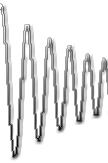 |
 |
|
 |
 |
|
|
|||||||
| Signals | Systems | System Response | |||||
| Frequency Representation | Fourier Series / Transforms | Background Material | |||||
Unit Sample Response
Previously, it was said that the unit sample response of a system was a unique way of defining it. Now, we'll take a look at how we calculate this.
Definition: Let hk[n] be the unit sample response to unit sample x[n] = δ[n-k] shifted to time ‘k’.



input = x[n] = δ[n-k]
output = hk[n]




Ex. Solving a difference equation to obtain the unit sample response.
Bank account difference equation:



To solve for the unit sample response to must set the input to the impulse response function and the output to the unit sample response.

|
|
|
|
|
|
|
|
|
|
|
|
|
|
|
|
|
|
|
|
Thus, we see that the unit sample response is:

which can also be written as:

Unit Step Response
The unit step response of a system is the convolution of the unit sample response with the unit step function. Another way of relating the unit step response to the unit sample response is via the derivatives and integrals. The unit step response is the integral of the unit sample response and the unit sample response is the derivative of the unit step response.
For example, let's take a look at what would happen if we solved the unit step response according to the definition (convolution of unit sample response with unit step function) versus if we integrated the unit sample response.

![]()




We can also integrate (or for discrete functions, sum over) the unit sample response, and realize the same result.


We can also derive this result by manipulating the integral both in the continuous and in the discrete case.
|
Continuous
|
Discrete
|
 |
 |
 |
 |
 |
 |
 |
 |
Sinusoidal Steady-State Response
The sinusoidal steady-state response of a system is the convolution of the unit sample response with the complex exponential function. We can see how this looks with the bank account difference equation.
![]()
![]()
![]()
![]()



Canonical Response
The canonical response is a way of portraying the transfer function of a particular system. Let's take a look at some individual parts of a complete system. An important point to remember is that the canonical response (or block diagram) can be drawn in both frequency domain as well as time domain. First, let's see how summation of two signals is represented.

Another important building block is the multiplicative factor. This is frequently represented as an arrow with a constant written above it or represented by a box inserted between the end and the head of the arrow.
![]()


The individual parts of a system can be combined to form a complete system.


Let's take a look at some actual systems and how we can model their canonical response. For the transfer function: 
The model looks this:

A more complicated system might be represented by the transfer function, ![]()

|
For comments and suggestions on this page, please click the link below: |